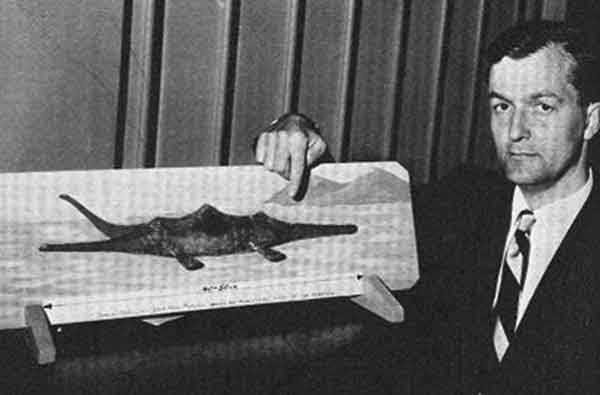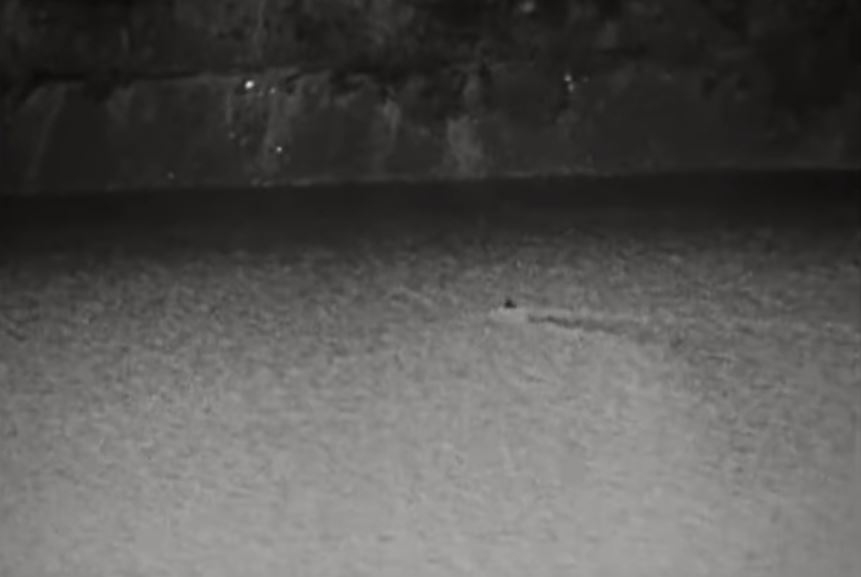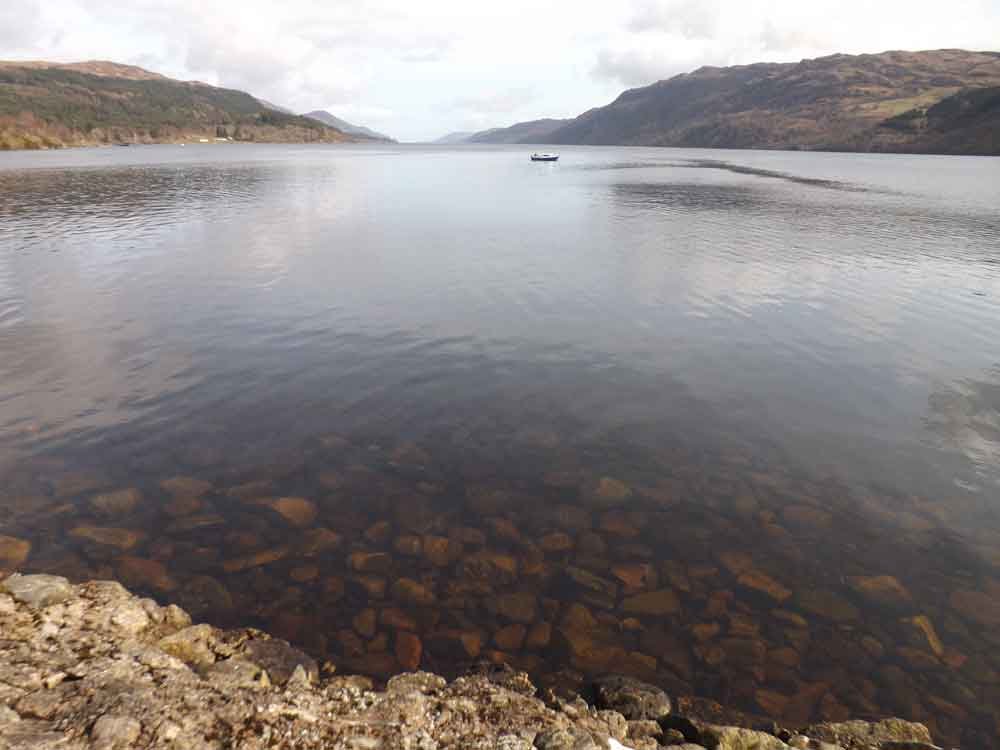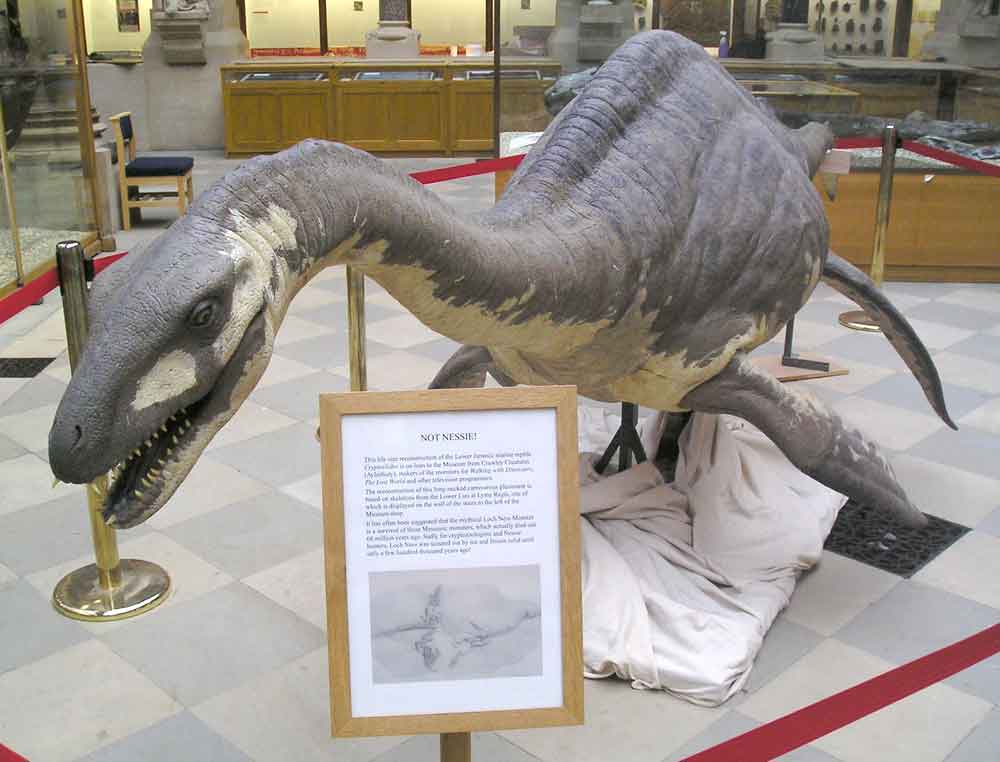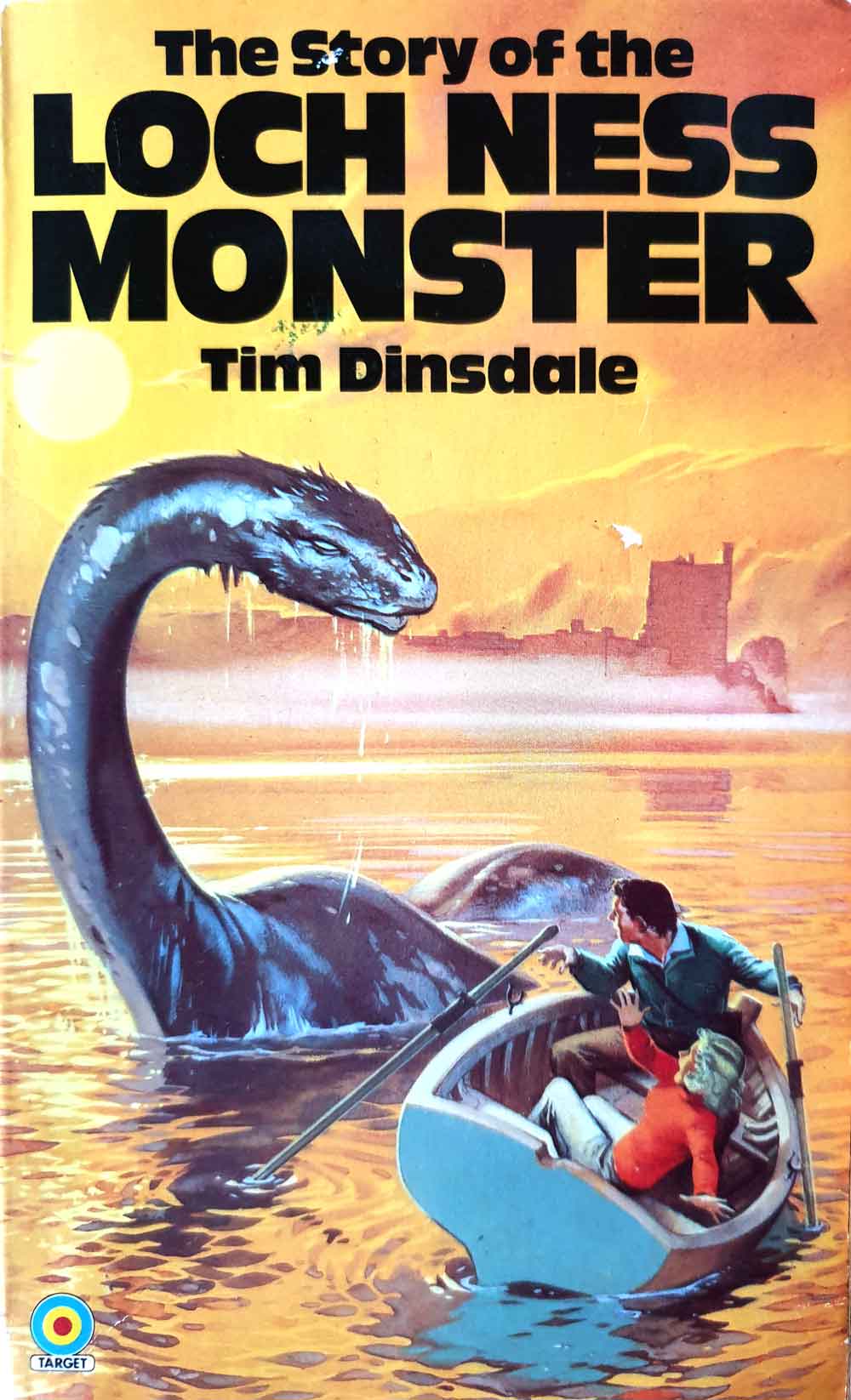The story of the Loch Ness Monster is not a zoological one, no matter how desperately those who support the alleged existence of the monster wish it were. It is, instead, the story of people. Of people who tricked others into thinking that they saw or believed in a monster, of people who really thought they had seen a monster, and of people who wrote about, and theorised about, the thoughts, beliefs and adventures of others who’d thought or claimed they’d seen a monster.
Caption: Tim Dinsdale with his own reconstruction of the Loch Ness Monster (a clay model, held in place on a painted wooden board). I presume this photo was taken on the set of the BBC Panorama studio. Image: (c) Tim Dinsdale.
One of the most important characters as goes popularisation of the monster and promotion of its ostensible reality remains aeronautical engineer Tim Dinsdale (1924-1987). Over the three decades in which he was involved in the Loch Ness Monster story, he wrote four Nessie-themed books (Dinsdale 1961, 1966, 1973, 1975; not counting later editions), produced the text for a map (Dinsdale 1977), procured what remains the most famous piece of Nessie-based camera footage, and was deeply and closely involved in several campaigns and schemes to have the Loch Ness Monster formally recognised as a genuine animal species deserving legal protection.
Caption: covers of Dinsdale’s Loch Ness books - though not depicting all editions. Image: Darren Naish.
Those familiar with Dinsdale’s writings will already know the basics as goes his involvement in the Nessie saga. However, a lengthy work dedicated to his life and adventures was always needed, and I’m pleased to say that this gap in the literature was filled in 2013 by Angus Dinsdale’s The Man Who Filmed Nessie: Tim Dinsdale and the Enigma of Loch Ness (A. Dinsdale 2013). This second Dinsdale is Tim Dinsdale’s son, who has written an affectionate but never overly sentimental review of his father’s life.
Caption: cover of A. Dinsdale’s 2013 book The Man Who Filmed Nessie: Tim Dinsdale and the Enigma of Loch Ness.
My review here is the third and final part of the connected series on recently published books about the Loch Ness Monster (the other parts are here and here), though rest assured that it certainly won’t be the last thing I say on the subject since there are several other recently published works that warrant review as well (Ronald Binn’s 2019 The Decline of the Loch Ness Monster will likely be next). I appreciate that it might seem a bit odd to review a book published more than six years ago, but better late than never.
Caption: Dinsdale’s 1977 map is meant to be about Loch Ness in general. It is, of course, quite heavy on monster promotion (Dinsdale 1977). Image: Darren Naish.
The Man Who Filmed Nessie begins with several biographical chapters on Tim Dinsdale’s family background and early adult life. It is partly autobiographical, discussing the Dinsdale adventure as seen through the eyes of his son, but also includes long quoted sections from Dinsdale’s writings. In the text that follows, any mention of or reference to ‘Dinsdale’ should be assumed to refer to Tim Dinsdale, not Angus.
The story of how Dinsdale became seduced by the allure of the Loch Ness Monster is familiar to those who’ve read his books (Dinsdale 1961, 1975) and those written about him (e.g., Witchell 1975, Binns 1983, 2017, Campbell 1986, Williams 2015). For a level-headed person with a ‘practical’ background as an engineer, it’s remarkable how quickly Dinsdale became essentially convinced by the monster’s reality. This revelation wasn’t achieved after a personal encounter with the beast, nor after he’d spoken to some number of sincere witnesses. No: he read a single article in a popular magazine (Everybody’s magazine), titled ‘The Day I Saw the Loch Ness Monster’ (A. Dinsdale 2013, p. 42).
Caption: Dinsdale’s identikit rendition of what the Loch Ness Monster must look like, reconstructed by taking averages from the various eyewitness encounters he’d read. Image: Dinsdale (1960).
Inspired and excited, he decided that he had to go to Scotland to see the beast for himself, so off he went. Aaaand… immediately saw Nessie! Yes, on the very first day of his arrival at Loch Ness (16th April 1960), Dinsdale thought that he’d seen Nessie. It turned out to be a floating tree trunk (A. Dinsdale 2013, p. 51). On 21st April 1960 (the fourth day of his scheduled expedition at the loch) – shortly after spending time with water bailiff and Nessie oracle Alex Campbell – he again saw, and this time filmed, Nessie: “a churning ring of rough water, centring about what appeared to be two long black shadows, or shapes, rising and falling in the water!” (A. Dinsdale 2013, p. 62). And on the final and sixth day of his expedition (23rd April 1960) he again saw and filmed Nessie, this time procuring the famous Foyers Bay footage, featuring a humped object – Dinsdale likened it to the “back of an African buffalo” – moving across the loch. After obtaining control footage of a boat (albeit at a different time of day, in different lighting conditions, and with a white-hulled boat obviously different from the mahogany ‘monster’), Dinsdale immediately messaged the British Museum, his reasoning being that the leading zoological institution of the country should hear about it first. After having the film developed, he waited, honestly expecting an excited cadre of professional biologists to beat a path to his door. After about seven weeks of silence, he gave up waiting and went to the press, his ultimately successful plan being to have the footage screened on the flagship BBC news programme Panorama.
Caption: a screengrab from the approximately 1 minute long Dinsdale film of April 1960. The dark object was thought by Dinsdale to be the mahogany brown, ‘peaked’ back of a massive aquatic animal. Image: (c) Tim Dinsdale.
He brought along a clay monster model he had made, the fact that it had been kitted out with three humps now appearing inconsistent with the monster shown in the footage. Alex Campbell also featured on the same TV show. To Dinsdale’s eyes, the Panorama experience was not merely crucial as goes the promotion of his case, but valuable in the scientific sense since the “increase in definition and contrast” made to the film by the TV people improved its clarity and shed additional information on the appearance of the Loch Ness animal.
Caption: a key character in the Loch Ness saga is water bailiff and journalist Alex Campbell. While at Fort Augustus, I got to see his waterside home, Inverawe. It’s the building at far right here. Dinsdale spent time with Campbell immediately before seeing and filming his ‘monster’ of April 1960. Image: Darren Naish.
Our view of Dinsdale’s film today is that it isn’t impressive and almost certainly doesn’t depict a monster. There were surely viewers at the time who must have been equally unimpressed and Dinsdale’s view that the scientists and specialists who viewed the film in secrecy displayed nothing but apathy (A. Dinsdale 2013, p. 73) is, of course, a biased take since he simply expected them to agree with his interpretation. The object he filmed was no giant unknown aquatic animal, but a boat (Binns 1983, Campbell 1986, Harmsworth 2010, Naish 2017; and see Dick Raynor’s page on the footage here).
Caption: Loch Ness is often a beautiful and serene body of water, but I can’t help feeling that it must seem remote and lonely at times of the year. This photo was taken in the Spring of 2016. Image: Darren Naish.
Prior to reading this book, my feelings about Tim Dinsdale were tempered by the fact that I thought him odd for abandoning his family for long stretches while engaging in the esoteric pursuit of an alleged mystery beast in a part of the country far from home. Furthermore, my idiosyncrasies mean that I’m automatically jealous or resentful of anyone who gets to engage in an expensive hobby at what appears to be infinite leisure.
Caption: few people seriously interested in the Loch Ness Monster can claim to have spent as much time on, or close to, the waters of the loch as Dinsdale did. But many people familiar with Dinsdale’s writings have sought to follow his footsteps, at least in part. Image: Darren Naish.
It turns out that none of these things are true. Dinsdale’s monster-hunting came at great personal expense and involved some degree of hardship. Furthermore, he deliberately included his family in his monster-hunting expeditions. I particularly liked Angus’s description of the childhood tradition in which he would procure the largest available carrot from the supermarket; this was to accompany his father on an expedition, the plan being that it would be fed to Nessie once she and Angus’s dad had made friends (A. Dinsdale 2013, p. 86). Whatever Dinsdale’s legacy, the lives of his children were surely enriched by their regular trips to Scotland and their involvement in something as unusual as the pursuit of the Loch Ness Monster, though I have to admit that my personal circumstances while reading this book – I was working in China and missing my family – probably influenced my sentimental feelings on this issue.
Caption: you’ve probably read that the water of Loch Ness is tea-coloured. This is what it looks like when the bottom is less than 1 m away. Get to a depth of 10 m, and there’s essentially no light and nothing but darkness - at least, as far as the human eye is concerned. Image: Darren Naish.
While monster hunting, Dinsdale occasionally checked the shoreline. He was aware of the land sightings of Nessie and kept in mind the possibility that he might see the beast on land himself. I should mention here that refractory Nessie fan and blogger Roland Watson has recently published an entire book on the subject of land sightings, titled When Monsters Come Ashore. It’s written in extremely large font and in the bombastic and childish style characteristic of True Believers and is surely not a fair continuation of the level-headed and restrained, respectful tone of Dinsdale’s writings. In other words, poor Tim would not be happy with the state of Nessie promotion occurring among those few who might consider themselves his modern disciples.
One of the most interesting sections of the Nessie story concerns the arrival of the Americans and the use of assorted high-end bits of mechanical and photographic kit. While it might have seemed that Dinsdale and other British Nessie-hunters could have been gradually edged out of the quest, Robert Rines and his colleagues were on good terms with Dinsdale and even helped win him a lecture tour of the US, and ultimately to appear on big-hitting TV shows like The David Frost Show and The Tonight Show Starring Johnny Carson (A. Dinsdale 2013).
Caption: a Loch Ness scene, fortuitously featuring a waterbird (in this case, a Mute swan Cygnus olor) and a boat. Both objects have undoubtedly contributed in no small part to the phenomenon known as the Loch Ness Monster. Image: Darren Naish.
Indeed, Dinsdale’s fame reached its peak during the early and mid 1970s, as did the quest for Nessie in general. The mounting excitement that something was surely there and due to be confirmed – a belief fuelled by all that fancy American technology – inspired the idea that Nessie-like animals might lurk in other, nearby bodies of water. The book recounts Dinsdale’s expedition to Loch Morar, a place very different from Loch Ness but also said to have its own monster, called Morag. The main point of interest here to monster nerds is that the Dinsdales happen to meet a Mrs Parks, sister to one of two men who claimed a close Morag encounter.
Caption: Dinsdale was never explicit about the zoological identity he favoured for the Loch Ness Monster, but he clearly favoured the idea that it was a living plesiosaur, albeit one that had undergone a fair amount of change since the end of the Cretaceous. The legend of the late-surviving plesiosaur - reflected in this model, made for a TV show and photographed at the Oxford University Museum of Natural History in 2005 - owes something to Dinsdale’s writing. Image: Darren Naish.
The story – recounted in several monster books – is famous because the two men (Duncan McDonell and William Simpson) apparently had to use an oar to fend Morag away from their boat, and so vigorous was the interaction that the oar snapped. The story usually ends there. Another Nessie-themed book, however, explains how the individuals concerned had been poaching deer and were trying to discard an unwanted skin which, despite being filled with stones, refused to sink. Eventually it had to be whacked with an oar, and here we find what is claimed to be the actual explanation for the oar-breaking event (Harmsworth 2010, p. 218).
Caption: the ‘two people in a lake come so close to a monster that they have to hit it with an oar’ trope has been taken seriously enough to inspire this re-enactment, this time involving the Lake Storsjö monster of Sweden. The man with the oar is Ragner Björks. Image: Bord & Bord (1980).
In places, Dinsdale’s story arc is a melancholy one. He wrote of his realisation, years after his initial forays in boats on Loch Ness, that he had become an experienced and confident boatman, his long, quiet stretches involving grey water, and rain. He never was to experience anything again as thrilling as his 1960 filming of the ‘monster’s hump’, nor did this footage receive the accolade he hoped it would. The decline and demise of the Loch Ness Investigation Bureau during the early 1970s marked “the end of an era” (A. Dinsdale 2013, p. 200), and even the 1975 scientific symposium – the high water mark of Nessie’s scientific respectability, convened to discuss the sonar traces and photos obtained by Rines and his colleagues – was regarded as a disappointment (A. Dinsdale 2013, p. 217). As scientific interest in Nessie waned during the 1980s, Dinsdale complained in 1987 that scepticism had taken over, that “Nessie in the 80s has, if anything, been going backwards” (Williams 2015, p. 202). A planned sequel to 1975’s Project Water Horse, intriguingly titled Loch Ness and the Water Unicorn, and said in the 1982 edition of Loch Ness Monster to be partly written, never appeared in print (Binns 2019).
Caption: scientific interest in Nessie might have waned during the 1980s, but this was the decade that gave us this fantastic book cover. You might doubt that encounters as close and thrilling as this ever occurred. It belongs to the sixth edition of this book, published in 1982.
Some authors, especially those championing the Loch Ness Monster’s existence, have framed Tim Dinsdale as the most brilliant, wise and relevant authority on the Loch Ness Monster (pro-Nessie author Henry Bauer is an example). It’s easy to be convinced from Dinsdale’s writings, and his son’s, that he was indeed sincere, honest, and trying as best he might to stir scientific and mainstream interest in something that he regarded as unquestionably real. And his underlying methodology was scientific. But he seemed never to grasp why the official response was one of apparent disinterest and apathy. It wasn’t down to “stubbornness … indifference … [and] arrogance” (A. Dinsdale 2013, p. 232), but to the fact that the evidence just wasn’t good enough, and that there never was a good reason to believe in a monster. That Dinsdale became almost fixated on the monster’s existence after reading a single popular magazine article does not – I have to say it, forgive me – seem consistent with someone who might be deemed wise, level-headed and of the most sceptical, rational approach.
Caption: the Peter O’Connor photo of 1960 - this is a low-res, cropped version - has appeared several times at TetZoo over the years and is almost certainly a hoax, most likely an overturned kayak and a model head and neck (Naish 2017). Dinsdale included it in early editions of his book Loch Ness Monster but it - and any accompanying prose devoted by Mr O’Connor - is absent from the fourth edition and those that appeared afterwards. Image (c) Peter O’Connor.
On that note, and while it again shames me to say it, I’m impressed – if that’s the right word – by Dinsdale’s naivety when we look at specific parts of his Loch Ness experience. Take his interaction with Tony Shiels, the self-proclaimed Wizard of the Western World. In 1977 Shiels claimed to capture on film the most remarkable colour photos of Nessie ever taken, an object affectionately known today as the Loch Ness Muppet. Any familiarity with Shiels and his adventures quickly reveals that he has, and seemingly always has had, a tongue-in-cheek, jovial take on monsters and how they might be seen. They’re not really meant to be undiscovered animals lurking in remote places, but interactive pieces of quasi-surreal art akin to open-air theatre, the ensuing cultural response in literature and news being as much a part of the event, if not more, as the claimed sighting and photo. While I undoubtedly write with the benefit of hindsight (and, dare I say it, some quantity of insider information), Dinsdale was seemingly unable to perceive this. And thus the muppet photo appears – as a legit image of the Loch Ness animal – on the cover of the fourth edition of Dinsdale’s The Loch Ness Monster, a decision that speaks volumes.
Caption: the infamous 1977 Shiels muppet photo. Exactly what it depicts (a plasticine model superimposed on a scene showing water? A floating model posed in the loch?) remains uncertain. Image: (c) Tony Shiels.
The Man Who Filmed Nessie: Tim Dinsdale and the Enigma of Loch Ness is an essential read for those seriously interested in the history of monster searching and the people who engage in it. The book has very high production values and impressive design and editorial standards, and includes an excellent colour plate section. I enjoyed reading it and think that Angus Dinsdale has produced a book that his late father would have been proud of, and moved by. Many interesting people have contributed to the lore of the Loch Ness Monster, and Dinsdale was without doubt one of the most important and influential. I leave you to judge whether this was time wasted, or a life enriched and made remarkable.
Dinsdale, A. 2013. The Man Who Filmed Nessie: Tim Dinsdale and the Enigma of Loch Ness. Hancock House, Surrey, BC Canada. pp. 256. ISBN 978-0-88839-727-0. Softback, refs, index. Here at amazon. Here at amazon.co.uk.
Nessie and related issues have been covered on TetZoo a fair bit before, though many of the older images now lack ALL of the many images they originally included…
The Loch Ness monster seen on land, October 2009 (now missing all images due to hosting issues)
Dear Telegraph: no, I did not say that about the Loch Ness monster, July 2011 (now missing all images due to hosting issues)
Photos of the Loch Ness Monster, revisited, July 2013 (now stripped of all images, so completely useless)
Is Cryptozoology Good or Bad for Science? (review of Loxton & Prothero 2013), September 2014 (now stripped of all images)
My New Book Hunting Monsters: Cryptozoology and the Reality Behind the Myths, February 2016
Books on the Loch Ness Monster 1: Ronald Binns’s The Loch Ness Mystery Reloaded, March 2019
Books on the Loch Ness Monster 2: Gareth Williams’s A Monstrous Commotion, March 2019
Refs - -
Binns, R. 1983. The Loch Ness Mystery Solved. Open Books, London.
Binns, R. 2017. The Loch Ness Mystery Reloaded. Zoilus Press.
Binns, R. 2019. Decline and Fall of the Loch Ness Monster. Zoilus Press.
Bord, J. & Bord, C. 1980. Alien Animals. Granada, London.
Campbell, S. 1986. The Loch Ness Monster: the Evidence. The Aquarian Press, Wellingborough, UK.
Dinsdale, T. 1961. Loch Ness Monster. Routledge & Kegan Paul, London.
Dinsdale, T. 1966. The Leviathans. Routledge & Kegan Paul, London.
Dinsdale, T. 1973. The Story of the Loch Ness Monster. Target, London.
Dinsdale, T. 1977. The Facts About Loch Ness and the Monster. John Barthlomew & Sons, Edinburgh.
Harmsworth, T. 2010. Loch Ness, Nessie and Me. Harmsworth.net, Drumnadrochit.
Naish, D. 2017. Hunting Monsters: Cryptozoology and the Reality Behind the Myths. Arcturus, London.
Williams, G. 2015. A Monstrous Commotion: the Mysteries of Loch Ness. Orion Books, London.
Witchell, N. 1975. The Loch Ness Story. Penguins Books, Harmondsworth, Middlesex.

